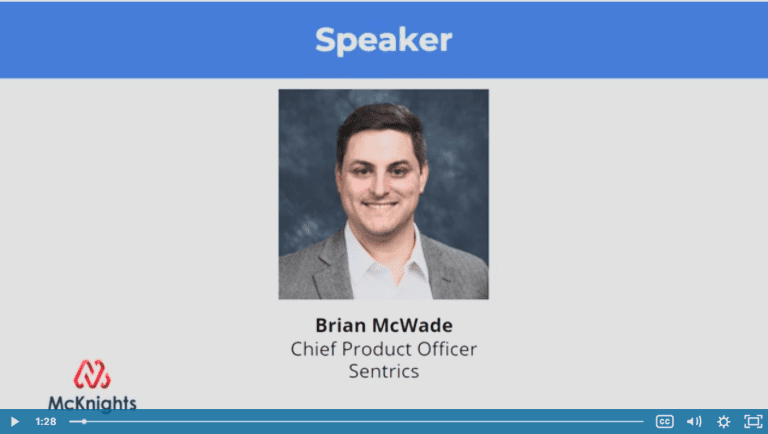A by-product of COVID-19 is the speed of change around managing the care of seniors. Many hospitals continue to focus on critical conditions. Physicians limit office hours and conduct more visits by phone and video. And many procedures are simply delayed. For residents in senior living communities, chronic disease management checkups are delayed or cancelled. It is common for senior living residents to have between 4-8 chronic conditions1 that could require oversight. This change in care management has put their health at risk.
Fortunately, many senior living communities are filling the gap. They are partnering with physicians’ offices. They are expanding their staffs to provide more traditional healthcare services. Some are partnering with or starting Medicare Advantage plans to manage the day-to-day health of residents.
Healthcare and senior living are converging into a single, integrated, population health management service. And it is being met with significant measures of success. Traditionalists question this approach. In reality, senior living communities are perfectly positioned to manage resident healthcare. They are responsible for the wellbeing of their residents. They have oversight over meals, exercise, and even mental health (the traditional Social Determinants of Health (SDOH) factors). They also oversee the residents’ activities of daily living. For these operators, managing the health of residents is a natural extension of the services they already provide.
By healthcare standards, it’s a ready-made population health management ecosystem. While population health has been the realm of traditional providers and insurance companies, senior living communities are perfectly positioned to take over the management of these populations of “like” care needs. It is one more step in the convergence of healthcare and senior living. And, one step closer to managing social determinants of health for many at-risk seniors.
What is Population Health?
At its essence, population health management is based on the idea of creating efficiencies in a cohort of people, whether they be patients, members or residents. This group of people could all live in the same community, or suffer from the same chronic condition, like diabetes. A population health approach measures the outcomes of a person over time, and not just a single episode. This comprehensive, overarching model emphasizes:
- Wellness
- Prevention
- Proactive, coordinated care
- Industry-standard best practices
Increasingly, healthcare providers are defining and segregating populations into groups of people with similar health conditions and needs. One of those populations could be a senior living community.
Healthcare Challenges Drive Change
Three overriding healthcare challenges make senior healthcare management ripe for a change: chronic conditions, fragmented care, and cost of care.
Seniors Have Multiple Chronic Conditions
As people get older, the likelihood of having multiple chronic conditions increases exponentially.
The majority of seniors—people aged 65 or older—have at least one and likely several severe, pre-existing, health conditions. According to the National Council on Aging (NCOA): “Approximately 80% of older adults have at least one chronic disease, and 77% have at least two. Four chronic diseases—heart disease, cancer, stroke, and diabetes—cause almost two-thirds of all deaths each year.”
With a typical care model, a primary care physician may only see a senior twice a year. With this infrequent visitation schedule, healthcare providers lack visibility over a disease’s progression or a patient’s condition.
On the other hand, staff in senior living communities see these residents every single day. This constant interaction and monitoring gives them greater oversight, making it much more likely that they recognize a change in health or behavior.
Fragmented Care
Because the healthcare system is divided into specializations, care for seniors is often fragmented. Specialists aren’t as likely to coordinate with one another.
Residents with traditional Medicare are not required to have a primary care physician coordinate the care between the specialists. This means that no single doctor oversees the management of chronic diseases; rather, they are focused on treating each specific chronic issue individually. This can create problems like contraindicating medicines or conflicting health advice.
It also makes it incredibly difficult to determine exactly how each chronic health condition is affecting the others.
Rising Costs
Providing care, especially overnight care, is costly. The cost increases with each chronic condition. According to Senior Housing News:
As people age, these conditions multiply: it is common for senior living residents to have between four and eight conditions. At Bluestone Physician Services in Stillwater, Minnesota, the average patient has nearly nine chronic conditions. These conditions are costly. Americans with five or more [chronic conditions] spend 14 times [more] on health services than people with none.
As costs rise across the board, senior living community operators have an opportunity to manage residents’ healthcare, particularly since they already have oversight on and interactions with their residents.
The combination of senior living and healthcare management typically results in lower costs, improved quality and increased length of stays. This benefits the system and the resident. For instance, Geisinger’s 65 Forward2 set up locations across the health system’s markets on the East Coast. These were created specifically to provide primary care and wraparound services to support seniors’ long-term wellbeing and chronic health management. The early results are better patient satisfaction and reduced healthcare costs.
Senior Living Communities are the Vehicle for a Population Health Model
Senior living communities are perfectly positioned to manage a patient population—both as a whole and on an individual level—to improve communication surrounding care, and to deliver the most efficient care possible.
What solutions are they embracing to drive a population health model?
On-Site Primary Care
To be successful today, senior living communities must focus on both hospitality and healthcare. According to Brenda Bacon, CEO of Brandywine Living: “We don’t have to be a junior version of the hotel industry or a junior version of the healthcare industry. We can be our own industry because it is a unique product.”
Senior living communities are seeking to bridge the gap by providing on-site healthcare services with population health promoting features like 24/7 resident nurses and convenient telehealth services.
Doing so ensures that residents receive regular attention, checkups, and a holistic approach to their “whole” health; while decreasing the potential harms and inconveniences of leaving the community for health checkups.
The communities with integrated primary care within their resident services model have experienced noticeable benefits.
- After adding a primary care element to its service offering, Juniper Communities’ hospitalization rates dropped more than 50%1 compared to the rates of hospitalization from the average profiled population. And Ohio Living’s work in Toledo had a hospital readmission rate that was below 3.5%, compared to the market average of 18%.
- More than 236 communities brought Doctors Making Housecalls clinicians to communities, which resulted in the following3:
-
- A six-month increase in length of stay
- An estimated cost savings of $5 million
- A 60% reduction in 30-day readmissions
- A 40% reduction in hospitalizations
- A 70% reduction in trips to the emergency department
- An 8.1% reduction in overall healthcare costs
Whole-Health Management
As the name implies, whole-health management focuses on the entirety of a person’s health, including their physical, medical, social, and behavioral factors and outcomes.
A newer addition to this list is behavioral health, as the industry comes to terms with the impact mental health issues can have on health outcomes. When residents feel depressed, anxious, or isolated, their health will likely decline. In addition to the physical, medical and social services senior living communities offer, they are now integrating behavioral services that include:
- Coordinating care and creating a resident-centered medical home to help optimize the information exchange between primary and behavioral healthcare providers. This includes sharing information within residents’ electronic healthcare records in compliance with HIPAA requirements.
- Establishing an automated system for initiating referrals based on triggers like anxiety, depression, or substance abuse.
- Using standardized screening scales to gauge the efficacy of both individual care and the overall care model.
- Holding frequent meetings with caregivers for training, planning, and identifying concerns.
Data-Driven Insights
To embrace population health, many senior living communities have installed integrated life safety, entertainment, and engagement platforms that capture tens of thousands of data points daily—all without invading residents’ privacy—and feed that information into an AI-based platform to identify trends and predict outcomes. Data-driven insights help caregivers recognize minute changes in behavior and health, and help them tie them to a larger health issue much more quickly than a standard primary care physician, including:
- Changes in sleep patterns
- Struggles adjusting to new medications
- Becoming more isolated or easily agitated
- Changes in mood
- Physical deterioration or balance issues
- Changes in eating patterns
- Nervous energy
- Sudden disinterest in a favorite activity
The data brings potential concerns to the forefront early, so the care staff can be more proactive in informing the right health professional. While they have always brought changes to the attention of healthcare professionals as soon as they notice them, the right data and insights accelerate that timeline.
Plus, with integrated healthcare, the teams are more accessible. Therapists, podiatrists, social workers, physicians, and PAs work right alongside the caregivers in the community. They participate in quality assessments and fall risk meetings. They also help in care planning. Because the whole team is on the same page and communicates freely and easily, resident care improves.
The more information caregivers have about resident populations and individuals within them, the better primary care they can deliver to their residents. These powerful platforms provide operators with the data and insights they need to predict and prevent adverse actions, reduce hospitalizations, and lower overall costs. Actionable, proactive data also improves caregiver efficiency, effectiveness, and satisfaction.
Population Health and Senior Living Communities
For senior living communities seeking to create a competitive advantage in the marketplace, embracing population health, with integrated primary care, is the solution. A data-driven holistic healthcare model improves resident experience and population health. In turn, it decreases care costs, improves caregiver satisfaction, and gives families the peace of mind they need to confirm they made the right choice.
It’s a win for both parties.
The question is: will you take the leap?
If you need a technology partner, Sentrics has the integrated technology platform your team needs to create a population health model that will benefit both your residents and staff.
Sources:
- Senior Housing News. 4 Reasons Why Onsite Primary Care is Mission Critical for Senior Living. https://seniorhousingnews.com/2019/01/31/4-reasons-why-onsite-primary-care-is-mission-critical-for-senior-living/
- Senior Housing News. Welltower, Geisinger Tie Medicare Advantage to Middle-Market Senior Living. https://seniorhousingnews.com/2020/02/26/welltower-geisinger-tie-medicare-advantage-to-middle-market-senior-living/
- Senior Living News. Onsite primary care benefits operators, residents: data. https://www.mcknightsseniorliving.com/home/companies/onsite-primary-care-benefits-operators-residents-data/
- The Hospitalist. Why Hospitalists Should Embrace Population Health. https://www.the-hospitalist.org/hospitalist/article/121949/why-hospitalists-should-embrace-population-health
- NCOA. Healthy Aging Facts. https://www.ncoa.org/news/resources-for-reporters/get-the-facts/healthy-aging-facts/
- CDC. Chronic Disease. https://www.cdc.gov/chronicdisease/about/index.htm
- Senior Housing News. Changemakers. https://seniorhousingnews.com/2020/06/16/changemakers-brenda-bacon-brandywine-living-president-and-ceo/



